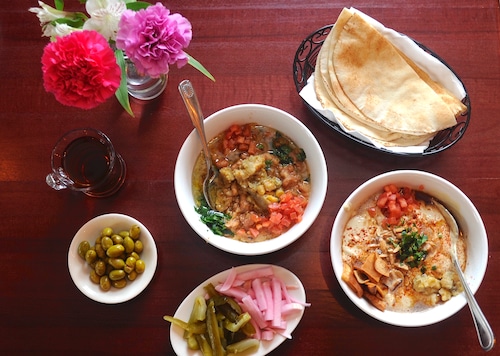At its best, food encapsulates this complicated life into one bite.
I experienced this rare event last week at Yasmeen (Jasmine in Arabic), a Middle Eastern restaurant in Clifton, when I devoured two dishes popular during Ramadan. The holy fasting month for Muslims begins Sunday and lasts until April 10th.
The first dish was fatteh, chickpeas with crispy pita, tahini and yogurt sauce, garlic, lemon, extra virgin olive oil and roasted nuts on top. The second was foul (pronounced “fool”), fava beans with tahini sauce, tomatoes, parsley, extra virgin olive oil, lemon and onions.
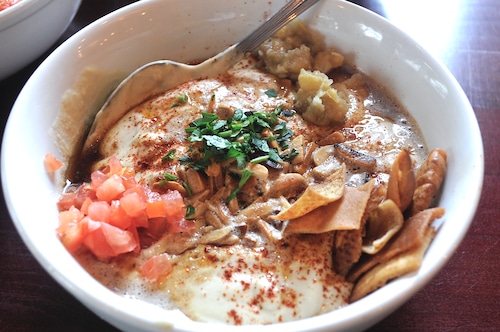
Fatteh remains one of the most authentic, and delicious, Syrian specialties.Karim Shamsi-Basha
Owner Mahmoud Chaghlil, 69, immigrated to the United States from Syria in 1978 and has worked in the food industry ever since, overcoming an early hinderance.
“I didn’t even know how to fry an egg,” Chaghlil told NJ Advance Media while laughing. “But my skills have improved, and now we have many regulars at Yasmeen. We put a lot of love in our food, and we serve a truly authentic Syrian cuisine.”
With Ramadan coming up soon, Chaghlil is selling plenty of traditional dishes.
“When you fast from dawn to sunset for a month, you need a lot of protein, and these two dishes provide that,” Chaghlil said.
I tasted the fatteh, closed my eyes and sighed as memories of my childhood returned. Chaghlil smiled. The dish had acidity from the lemon, creaminess from the yogurt, bitterness from the tahini, all with a contrast in texture from the crispy pita and soft chickpeas. In short, it was Ramadan-ready perfection on the plate.
Next, I tried the foul, which was glorious as well. The combination of lemon, garlic, tomatoes, parsley and extra version olive oil mixed well with that distinct taste of fava beans. The dish was savory with a memorable and appetizing aroma.
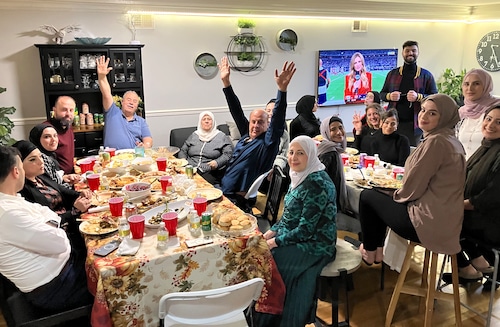
My sister Rowaida, front center, and her husband Imad, in blue shirt, host our large family gatherings at their Staten Island home.Karim Shamsi-Basha
In addition to familiar flavors erupting in my mouth, flourishing in my mind were recollections of me breaking the fast with my family in Damascus, Syria, where I was raised. I remembered impish things like kicking my brother’s foot under the table and frowning at my sister who had stuck her tongue out at me.
Mostly, I relived eating my mother’s fatteh and foul – to this day the two best things I’ve ever eaten (Yasmeen’s version is a close second).
But at the age of 18, I immigrated the United States and lost touch with those familial gatherings during Ramadan and other special occasions.
But around 20 years ago, my sister Rowaida moved to Staten Island with much of her husband’s family, and the vibrant gatherings returned, along with my very own Ramadan feel of family, love, and way, way too much food for one human stomach.
New to Ramadan? Maybe the following will shed a light.
Far-out family fun
Fasting the month of Ramadan is one of the five pillars of Islam, as big as Christmas for Christians. It is also time for families to get together for Iftar (Breaking the fast; or eating and drinking when the sun goes down). I loved everything about those insane get togethers, except when aunt Fatma would grab a hold of me and unload slobbery kisses all over my face. As a child, my main goal was misbehaving with my cousins and setting traps for my brother. One night, we put a bucket full of water over his room door while ajar. When he rushed in with his buddies, they were soaked from head to toe. I paid for the prank later, but it was worth it. Seriously though, there is nothing like a horde of people waiting for the call to sunset prayer to echo all over Damascus. This signals it was time to eat and drink, and ate and drank we did!
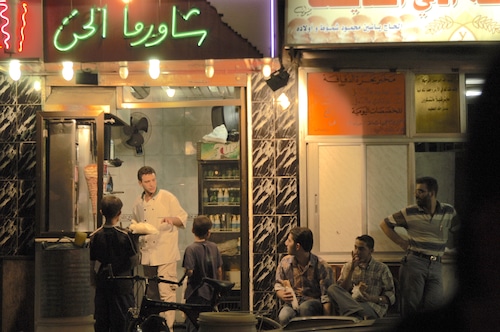
That's me, third from right, forty years ago, eating shawerma (That's what the sign says in Arabic) at a Damascus cafe about an hour after I broke the fast, with lots of food. I was hungry already.Karim Shamsi-Basha
Street life
After eating far too much foul and fatteh and a plethora of momma’s specialties like macaroni bechamel, fatayer and sfeeha, I would go out with my friends and wander the streets of our Abu-Rommana neighborhood. This was long before the recent civil war, and the streets would be packed with people strolling and eating and celebrating until the wee hours of the morning. We would fill up on cold cactus pears and boiled corn, listen to musicians playing their ney, oud and derbakeh instruments and watch street performers singing and dancing the dabkeh. It was like an Arabic carnival, and curfew was never enforced — another reason to celebrate.
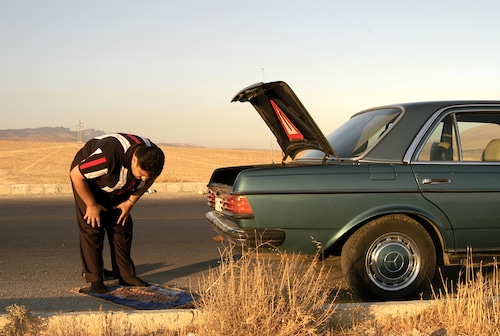
My friend Mumtaz Jimran had to pray before time for the afternoon prayer passed.Karim Shamsi-Basha
Matters of faith
Faith slides to the front of minds and hearts during Ramadan. One weekend during high school, I was riding with my friend, Mumtaz, in the mountains North of Damascus. Mumtaz suddenly stopped the car and went to the trunk retrieving his prayer rug. He proceeded to pray the afternoon prayer on the side of the road. The Islamic prayer take place at five set times during the day. He got back in the car grinning and said, “Only in Ramadan.” I remember going to the mosque more frequently while fasting, despite always wondering and debating about the veracity of religion.
Two quintessential drinks
Erk al-sous and tamarind are the two classic Ramadan drinks, the first made from the root of licorice plant, the second from Indian dates. I remember going to the ancient Al-Hamidiyah Souq (market) and watching their seller in traditional Syrian garb perform with his engraved copper kettle. He would fill a glass in one hand then toss it over his head to a glass in his other hand. The show was fascinating, and the drinks? Erk al-sous is slightly bitter with that unmistakable licorice flavor. Tamarind is much tangier with a lemony aftertaste.
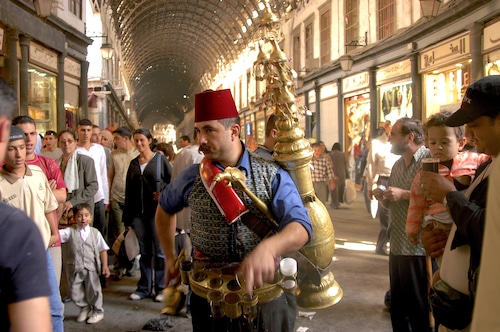
The seller of erk al-sous and tamarind at Al-Hamidiyah Souq wore the traditional Syrian dress with an authentic tarboosh - Arabian hat.Karim Shamsi-Basha
Eating ... again
After breaking the fast around seven in the evening, I would end up eating several times. My friends and I would hit popular spots and devour some mouth-watering Syrian specialties like shawarma, kafta, mihshee, yabra, ma’lubay - which I wrote about when my mother passed away last year. Ma’lubay was one of her many spectacular specialties.
Later, I would sleep a few hours only to awake before sunrise to eat again. Hey, an entire day with no food or drink needed a lot of fuel.
I don’t fast anymore, but a big part of me revels in my childhood memories of Ramadan, and in that one bite that could make the complicated very simple. Having moved to New Jersey only in 2022, I’m glad to find those delectable and very important dishes in the Garden State, too.
Karim Shamsi-Basha may be reached at kshamsi-basha@njadvancemedia.com. Follow him on Twitter & Instagram. Find NJ.com on Facebook.
